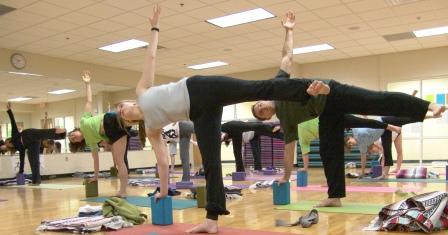There’s a revolution coming to the College of William and Mary, arriving in the form of brightly colored Lululemon mats and groove pants.
Yoga, one of the world’s most popular activities for exercising the mind, body and soul, is greatly increasing its presence at the College. Known for its vast physical and mental benefits, the ancient Indian practice has been lauded for the immediate gratifications and lasting transformations it provides to its participants.
There are an abundance of on-campus options to suit every level and schedule. Morning and evening classes are offered at the Student Recreation Center, the College’s official Yoga Club practices on a weekly basis, and two one-credit yoga classes are currently being offered for the fall semester in the department of kinesiology and health sciences.
Many local yoga studios in Williamsburg, such as the nearby Body Balance on Prince George Street, offer daily classes as well, including those of the “hot yoga” variety. Practicing students can rent out the squash courts in the Rec Center for a private and individualized yoga experience, or even soak up some rays while practicing their “downward dog” on the Sunken Garden.
The Rec Center offers eight yoga classes of varying rigor every week, each of which are almost always filled to capacity. Other yoga-based classes, such as yogilates, are also available and equally well attended. There are no pre-requisites to attend a class, except for the required purchase of a “Fitwell Pass,” which grants a student or faculty member unlimited access to all scheduled Rec Center classes. The cost for students is $45 per semester or $75 for the academic year. Yoga mats, blocks and straps are provided at no additional cost.
Sarah Prowitt ’14, who teaches both regular and “power” yoga classes, praised the Rec Center for its naturally inclusive community.
“The William and Mary yoga culture is special because you have teachers who work because they love the community,” Prowitt said. “The Campus Recreation department does a wonderful job of promoting wellness and how you feel about your body rather than promoting a one-size-for-all agenda. Yoga is for everybody, and we want you to take time and honor your body by practicing yoga … while classes can be very physically challenging, they can also help to re-charge and refresh your mind.”
Prowitt also took time to address some common rumors that plague the yoga culture. Flexibility is not essential for first-time students.
“You get more flexible by coming to yoga,” Prowitt said.
There are many different yogic philosophies and schools, rendering a stereotypical instructor or class invalid.
Although consistent practice results in physical strength, most notably in arm, leg and core muscles, yoga has also been notably regarded as a major source of mental health recovery and restoration, particularly in anxiety and depression. Patricia K. Charles, a faculty member in the department of kinesiology and health sciences and current instructor of the one-credit yoga classes, noted the vast increase of research and studies throughout the country, most recently at Boston University’s School of Medicine and UCLA, that verify the positive psychological benefits of yoga. Both studies reported significant decreases in anxiety and depression in people after yoga sessions.
Charles also noted yoga’s increasing presence in college communities, such as the University of Virginia’s reception of a $10 million grant to build a yoga center.
“It is a very exciting time to be teaching yoga,” Charles said.
Still can’t make it to a mat?
“Working with the breath is a simple yet effective method for dealing with stress, distress or anxiety,” Charles said. “If you can breathe, you can practice yoga.”

